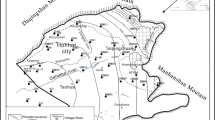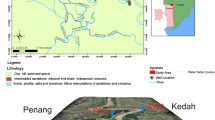Abstract
It is vital to outline the mechanisms of recharge of aquifers as far as water resources management is concerned. Monitoring variations in isotopic signatures (δ18O and δ2H) can provide us with valuable inputs on groundwater recharge processes. In the present study, the stable isotope (δ18O and δ2H) contents of groundwater, rainwater, and surface waters from the Northern parts of Kelantan, Malaysia, were employed to trace the recharge processes. In the Kelantan area, the recharge of shallow groundwater is mainly due to precipitation from northeast monsoon. The recharge mechanisms for shallow groundwater, especially in low-lying areas, are the infiltration of surface water. The primordial isotopic signatures (pre-evaporation) of post-season groundwater samples fall well within the isotopic range of post-season rainwater, signifying direct recharge from precipitation without any major fractionation. The narrow isotopic range for post-season implies that groundwater recharge for post-season occurs during a limited interval compared to pre-season. The aquifer in the area is isotopically heterogeneous and shows enrichment towards north-west during post-season and south-east during pre-season.
Access provided by Autonomous University of Puebla. Download conference paper PDF
Similar content being viewed by others
Keywords
1 Introduction
Population increase in Kelantan is putting a consistent and ever-increasing pressure on fresh groundwater resources. Groundwater is the main source of water supply in Kelantan as far as the drinking water supply is concerned. It is essential to assess and monitor the recharge in Kelantan area under any water resource management programme. Any variation in hydrogen (2H) and oxygen (18O) in precipitation forms the main primary data required for groundwater recharge investigations (Ingraham et al. 1998; Gupta and Deshpande 2003; Kortelainen 2009; Gat 2010; Voss et al. 2018). These include the sources and timing of recharge, retention time and circulation of groundwater (Kortelainen 2009). Such a study will require long-term data of stable isotopes in rainfall (IAEA/WMO. 2015). Regrettably, stable isotope data of precipitation in Kelantan are not available, nor has any detailed groundwater stable isotopic investigation been carried out yet. The meteoric water line, which is important in groundwater recharge evaluation, has not been established in the Kelantan. For a comprehensive groundwater recharge assessment, there is a need for additional isotopic data of rainfall in Kelantan meteoric line.
The main aim of the investigation is to understand the differences and relationships in isotopic compositions within various water types and to assess the source and mechanism of groundwater recharge.
2 Materials and Methods
The present study is confined to the northern part of Kelantan state in Malaysia which covers an area of approximately 1400 km2. The area lies between latitudes 5˚ 55” and 6˚ 15″ north, and between longitudes of 102˚ 4″ and 102˚ 25″ east (Fig. 1). Geologically, the area is covered by Quaternary sediments with granitic bedrock. The sediments from the quaternary comprise marine, fluviatile and other deposits observed in main rivers and coastal region. The study area experiences a humid tropical climate controlled by two monsoon seasons (i.e. northeast and southwest monsoon) and characterized by wet and dry seasons throughout the year.
Twenty-nine groundwater samples were collected uniformly over the entire study area during pre-seasons (January 2016) and post-seasons (June 2016), respectively. All the groundwater samples were collected from first aquifer in which groundwater depth is very shallow (< 8 m). Three surface water samples were also collected from river waters and other small tributaries from locations S1, S2 and S3. Apart from that, rain water samples were collected on monthly basis for a period of a year from July 2015 to June 2016 to create a local meteoric water line. Analysis of isotopic compositions of δ18O and δ2H is conducted at Malaysia Nuclear Agency using IRMS instrument.
3 Results
3.1 Isotopic Composition of Groundwater and Surface Water Samples
The average values of δ18O in groundwater during both pre-season and post-season are −5.30‰ and −6.40‰, respectively. From the calculated pre-season data, the regression line that best fit the equation is generated as follows:
The best fit regression line equations for groundwater samples collected during the post-season is expressed as:
From the analysis, the surface water has δ2H values in the range of −37.41 to −26.88‰, and δ18O values ranging from −6.9 to −5.9‰ during the pre-season. The average values of δ2H and δ18O during the pre-season are −33.78‰ and −6.47‰, respectively. For the post-season, the δ2H values are recorded between −38.45 and −33.17, while for δ18O, the value ranges from −5.7 to −5.63‰. The average value of δ2H calculated during the post-season is −35.52‰, whereas for δ18O values is −5.65‰, respectively.
3.2 Groundwater Relationships of Δ2H and Δ18O During the Pre-Season
The groundwater trend line equations slope reveals a less steep slope compared to LMWL trend lines as shown in (Fig. 2). An effort is made to identify the possible genesis of isotope sources in groundwater prior to process, such as evaporation, by evaluating the change in slope of both stable isotopic compositions of δ2H and δ18O as the trend line deviates from the local meteoric water line. Based on the plot, it can be understood that natural processes, such as evaporation, influence the water movements in the study area as it explains the scattering of the samples’ plots.
From the plots, three significant clusters are observed in terms of δ18O configurations in groundwater. The first cluster exhibits low δ18O, ranging from −8 to −5‰, with major groundwater plots. The second cluster ranges plots at around −4‰, with three groundwater plots, while the third cluster ranges from −2 to 1‰, with four groundwater plots. These different clusters may denote recharge of groundwater via rainfall activities, possibly from different monsoons, including north-east monsoons and south-west monsoons which transport precipitates with varying isotopic compositions. The cluster depicts varying recharging conditions which portray to similar depths. A closer observation of δ2H-δ18O composition during the seasonal changes depicts minor variations. These can be attributed to low residence periods of the water bodies.
3.3 Groundwater Relationships of Δ2H and Δ18O During the Post-Season
For the post-season, the groundwater trend line equation reflects a less steep slope compared to slopes of pre-season trend line as depicted in (Fig. 3). Yet, the pre-season trend line slopes are lower than the local meteoric water line. Few groundwater samples are observed to be plotted below the local meteoric water line denoting enrichment of isotope which occurs as a result of evaporation processes taking place directly upon the soil surfaces exposed during the recharge phase. For the post-season, most of the sample plots fall near the local meteoric water line which denotes processes such as evaporation that appear to impact the shallow groundwater system. Based on the plot of the trend line, it can be inferred that surface water samples from post-seasons are more prone to evaporation state compared to samples from the pre-season as surface water samples plotted during these period lie close and below the groundwater trend line as shown in (Fig. 3).
4 Discussion
A comparison of the stable isotopic signatures of groundwater and precipitation of both pre- and post-seasons indicates that the precipitations are the main source of groundwater recharge in the area. The recharge mechanisms for shallow aquifers, especially in low-lying areas are the infiltration of surface water. The primordial isotopic signatures (pre-evaporation) of post-season groundwater samples fall well within the isotopic range of post-season rainwater signifying direct recharge from precipitation without any major fractionation. The narrow isotopic range for the post-season implies that groundwater recharge for post-seasons occurs during a limited interval compared to the pre-season. A closer observation of δ2H-δ18O composition during the seasonal changes depicts minor variations. These can be attributed to low residence periods of the water bodies owing to the shallow nature of the aquifer. In addition, there is no clear indication of elevated values or abnormality in δ2H and δ18O values suggesting a single (or identical) input source(s) in the course of recharge period. The aquifer in the area is isotopically heterogeneous and shows enrichment towards the north-west during the post-season, and the south-east during the pre-season.
5 Conclusions
The application of stable isotopes has presented significant contributions and clarifications on groundwater systems. Based on the explanation, it can be inferred that most groundwater regimes are being recharged by the local precipitates or rainwater. Besides, the isotopic signature shows certain processes which influence groundwater and surface water, such as evaporation processes. To conclude, the groundwater resources in the study area commonly comprise sources from recent origins. Keeping the shallow nature of the aquifer in the area under consideration, all human activities which can directly or indirectly affect the aquifer must be monitored regularly. The findings of this study enable and quantify an enhanced understanding regarding groundwater resources in the northern parts of Kelantan, thus aiding and beneficiating related governance on developing systematic utilization methods to better manage these precious resources.
References
Gat, J.R.: Isotope hydrology: a study of the water cycle. In: Series on Environmental Science and Management, vol. 6. Imperial College Press, London (2010)
Gupta, S.K., Deshpande, R.D.: Synoptic hydrology of India from the data of isotopes in precipitation. Curr. Sci. 85, 1591–1595 (2003)
IAEA/WMO.: Global network of isotopes in precipitation. The GNIP database. Accessible at http://www.iaea.org/water (2015)
Ingraham, N.L.: Isotopic variations in precipitation. In: Kendall, C., McDonell, J.J. (eds.) Isotope Tracers in Catchment Hydrology, pp. 87–118. Elsevier, Amsterdam (1998)
Kortelainen, N.: Isotopic composition of atmospheric precipitation and shallow groundwater in Olkiluoto: O-18, H-2 and H-3. Working report 2009–06, Posiva (2009)
Voss, K.A., Bookhagen, B., Sachse, D., Chadwick, O.A.: Variation of deuterium excess in surface waters across a 5000-m elevation gradient in the east-central Himalaya. Hydrol. Earth Syst. Sci. (2018). https://doi.org/10.5194/hess-2018-534
Acknowledgments
The authors are highly thankful to the faculty of Earth Science, Universiti Malaysia Kelantan, Campus Jeli, for basic facilities to carry out this research work. Dr. Wan Zakaria from Nuclear Agency Malaysia is warmly thanked for providing vital inputs throughout this study. Funding: The financial assistance is received from Fundamental Research Grants (R/FRGS/A08.00/00644A/002/2015/000228 and R/FRGS/ A0800/00644A/003/2018/00556) is highly acknowledged.
Author information
Authors and Affiliations
Corresponding author
Editor information
Editors and Affiliations
Rights and permissions
Copyright information
© 2022 The Author(s), under exclusive license to Springer Nature Switzerland AG
About this paper
Cite this paper
Khan, M.M.A. et al. (2022). Stable Isotope Evidences on Mechanisms and Sources of Groundwater Recharge in Quaternary Aquifers of Kelantan, Malaysia. In: Chenchouni, H., et al. New Prospects in Environmental Geosciences and Hydrogeosciences. CAJG 2019. Advances in Science, Technology & Innovation. Springer, Cham. https://doi.org/10.1007/978-3-030-72543-3_131
Download citation
DOI: https://doi.org/10.1007/978-3-030-72543-3_131
Published:
Publisher Name: Springer, Cham
Print ISBN: 978-3-030-72542-6
Online ISBN: 978-3-030-72543-3
eBook Packages: Earth and Environmental ScienceEarth and Environmental Science (R0)







